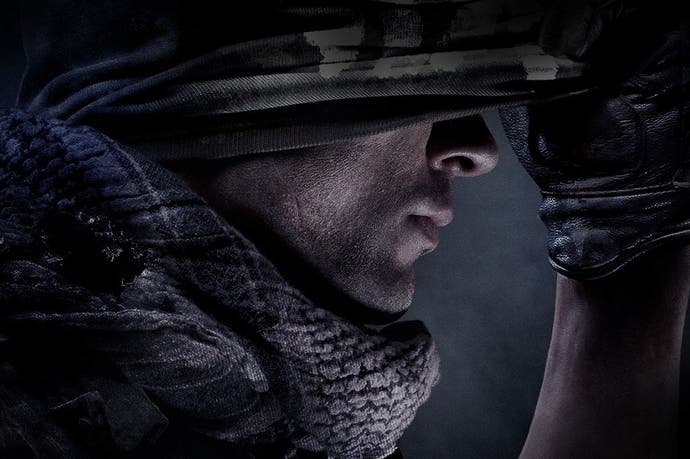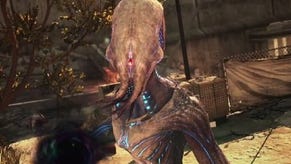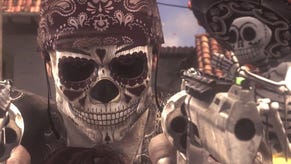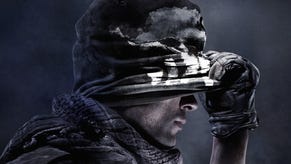Face-Off: Call of Duty: Ghosts
With next-gen coming soon, the PC shows us the way in this current-gen battle.
| Xbox 360 | PlayStation 3 | PC | |
|---|---|---|---|
| Disc Size | Play Disc: 7.6GB, Install Disc: 2.0GB | 11.4GB | 28.9GB (download) |
| Install | 9.6GB (total, 2.0GB mandatory) | - | 28.9GB |
| Surround Support | Dolby Digital | Dolby Digital, 7.1 LPCM, 5.1 LPCM | Set-up dependent |
Call of Duty's relentless targeting of 60fps gameplay defines the series, delivering responsive twitch-based gameplay that few titles can compete with, but the strict focus on maintaining such a high frame-rate comes at a cost: the series' potential to dramatically evolve and grow over time is limited by the narrow rendering budget available on a per frame basis, with each instalment offering up smaller refinements to the formula along with a modest boost in graphical spectacle along the way.
Building upon the groundwork laid down by past offerings, Infinity Ward attempts to push Call of Duty: Ghosts into the next generation while looking to add some of Battlefield's lustre to the series with the inclusion of dynamic environments, along with some advanced DirectX 11 features, including tessellation, HBAO+ and a new lighting model. But are we truly looking at a next generation experience, or simply another incremental jump forward for a franchise happy to stay mostly within its establish comfort zone?
The revelations surrounding the Xbox One and PlayStation 4 versions of the game suggests that we are indeed looking at more than just a scaled up port with a few extra graphical bells and whistles thrown in for good measure - native resolution is a disappointing 720p on the Microsoft platform, while on Sony's system the native 1080p presentation is said to be causing some distracting frame-rate issues, something we'll be getting to the bottom of imminently. Additionally, Infinity Ward takes a new approach to multi-platform development with Call of Duty: Ghosts from previous titles in the series, with the studio creating significantly different assets for current and next-gen consoles, and with the PC getting an additional boost in texture resolution above the XO and PS4 versions of the game as well.
The PS4 and XO versions are arriving with us shortly, but in the here and now, a close look at the graphical make-up of the current-gen console and PC builds reveals some startling differences, while also showing that the developers have found a little more room for improvement in the engine that powers the series on the current-gen systems. The inclusion of destructible scenery certainly increases the level of spectacle on offer, for instance, although the effect is purely for show with only limited interactivity taking place in scripted gameplay sequences.
So, to kick things off, let's start by turning our attention to the game on the 360, PS3 and Wii U, where we find there to be a few changes compared to last year's Black Ops 2 in terms of rendering resolution and anti-aliasing. To back the comparisons we actually have two galleries for you - a triple-format PS3/Xbox 360/Wii U 720p offering, along with a 1080p version that better emphasises the PC's visual dominance.
"Each current-gen version offers up a different solution to the sub-HD issue, with varying resolutions deployed for each game."
Alternative comparisons:
With Infinity Ward back at the helm, Xbox 360 owners are in familiar territory with an approximate 1024x600 framebuffer favoured by the developer's previous Call of Duty titles, while the PS3 version features a considerably murkier presentation more closely matching that of Black Ops 2, with native resolution coming in at just 860x600, resulting a soft-focused image. The use of 2xMSAA is present on both formats, and the technique tames some of the harsh edges that appear on-screen to a degree, at least on chunkier details. Sub-pixel crawling still is a common occurrence in both versions on distant objects, though, with artefacts appearing more prominently on the PS3 where the MSAA algorithm tends to break more often.
On the other hand, there are no surprises with the Treyarch-developed Wii U version of Call of Duty: Ghosts, which opts for the same 880x720 resolution as Black Ops 2 and is also joined by the inclusion of 2x multi-sampling anti-aliasing. Of the three console editions, this version comes the closest to matching a native 720p presentation, with the more cleanly defined edges providing a boost in sharpness over the 360 and PS3 versions. The 360 release does yield a smoother presentation due to the mild increase in softness from the heavier vertical upscale, but overall, it's Treyarch's take on sub-HD rendering that provides the most visually pleasing look among the current-gen consoles.
Besides the variance in overall image quality, the main difference between the current-gen consoles lies with how the artwork is presented on each platform. While the core assets are fundamentally identical across all consoles, both the PS3 and Wii U versions of Call of Duty: Ghosts feature a few problems where lower-resolution textures are prominently displayed across characters and the environments. In many instances the impact of this is relatively minor and hard to notice beyond the occasional blurry poster or door texture, but at worst we see large walls and entire characters appearing on screen with what looks like lower-quality level-of-detail settings applied, sometimes on a permanent basis throughout a particular scene and even a whole level. This is particularly prevalent on the Wii U game, where the drop in artwork quality is much bigger and occurs far more frequently.
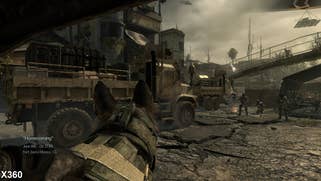
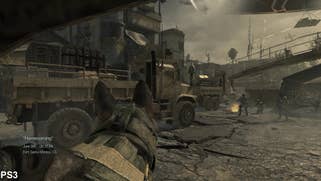
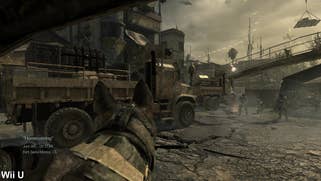

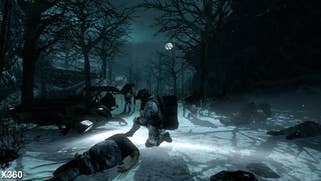
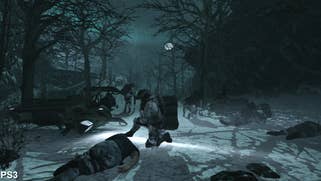
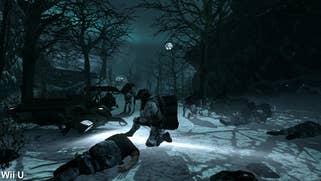


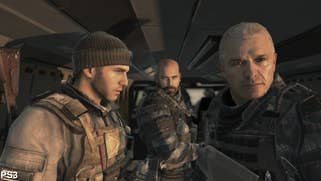
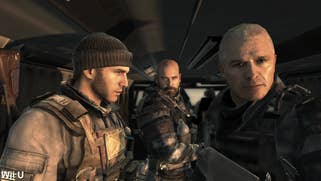
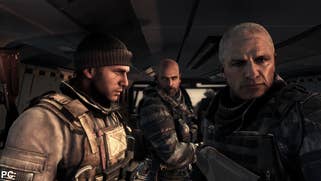
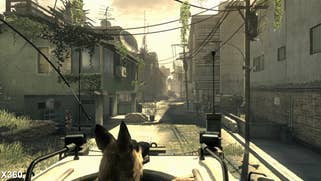
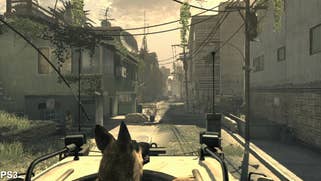
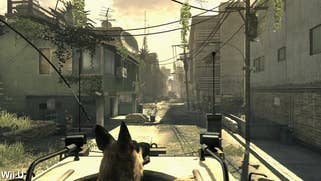


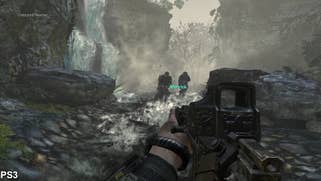
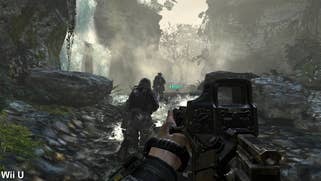
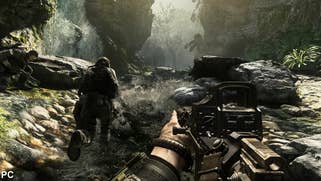
Quite why this is happening isn't immediately clear, but intriguingly the problem never really manifests on the 360, where a mandatory 2GB install is required before the campaign can be played. In comparison, on the PS3 and Wii U all graphical data is streamed directly from each system's disc drive, but at a slower rate than what is possible via a traditional hard disk. Perhaps the issues surrounding the artwork are caused by a bug in the game's streaming system causing incomplete assets to be displayed as the engine struggles to load in all of the relevant graphical data on platforms which rely on optical media to do so.
Beyond this, all three console versions are closely matched outside of a few barely notable variances which have little overall impact on the look of the game, such as the odd missing reflection on the Wii U or the use of lower-resolution specular effects on some surfaces on the PS3. However, the 360 version commands the overall advantage by featuring a more consistent presentation that lacks the blur surrounding the PS3 game, or the obvious texture bugs that appear on the Wii U.
The PC version: the first taste of the next-generation experience
The current-generation versions of Call of Duty: Ghosts yield few revelations then, and besides the introduction of scripted environmental destruction the engine upgrades are largely incremental in other areas. As we've seen with previous games in the series, it's a case of refinement over revolution where Call of Duty is concerned, and this is something that has always been the case for PC as well - until now. Despite being developed from the same core technology that powers the current-generation console editions of the series, the engine in the PC version of Call of Duty: Ghosts has seen some huge upgrades that deliver a visual experience completely removed from that of past games, and one closer in line with DICE's Battlefield 4.
The results are positively startling when comparing the PC game side by side with the 360, PS3, and Wii U editions, which appear soft and considerably lacking in detail in comparison. As a sign of what to expect from the 1080p PS4 version of the game, the PC release undoubtedly provides a worthwhile upgrade path for those undecided on which edition - current or next-gen - of the game they should go for.
Native 1080p resolution and beyond is joined by a wide selection of anti-aliasing options, including multi-sampling, FXAA, SMAA (sub-pixel morphological) and TXAA, which is exclusive to Nvidia graphics cards. For comparison purposes we decided to stick with 4xMSAA, although Nvidia's TXAA provides incredibly clean imagery that works well in creating clean jaggie-free imagery, at the expense of blurring the exquisite texture work on display.
"The PC version offers up our first taste of the next-gen experience and it's a huge step-up from the compromised current-gen versions of the game."
Alternative comparison:
Of all the improvements on offer here in the turbo-charged PC game, it is the use of lighting, tessellation and the dramatic increase in texture quality that really stands out. These elements, combined with use of displacement mapping and substantial increases in polygon count, bring about a whole new level of detail on the characters and the environments that better realise the war-torn locations and dramatic action at the forefront in Call of Duty: Ghosts.
The contours of commanding officer Elias' face appear smooth and properly rounded, with no visible polygon edges in sight - a treatment that also applies other key characters in the game, and also Riley, your combat-ready canine companion. Additionally, the detailed environments feature a degree of three-dimensionality simply not preset to the same degree on the 360, PS3, or Wii U games, with lower-quality textures and normal maps leaving such surfaces looking a lot flatter on those systems.
The substantial increase in artwork quality is also enhanced by a lighting model that appears completely different to the current-gen console versions. Simulated global illumination results in locations receiving indirect and much-improved ambient lighting. This creates a distinct contrast between areas bathed in shadow and those in the path of direct sunlight, completely eliminating the flat look of daytime scenes in the current-gen console versions of the game. Additional depth is also provided through the inclusion of HBAO+ (horizon-based ambient occlusion) that produces a thick shaded effect filling in all the nooks and crannies of the environment, characters and other objects in the scene.
On top of that we also see use of higher-precision effects for depth of field, lens flare, and light shafts - the latter element featuring a stronger more prominent real-time implementation that is deployed more liberally across the game. Object motion blur also makes its way to the PC version, and advanced surface shaders are deployed en masse across characters and environments, resulting in material properties - such as wetness, sheen and reflections - all handled with far more realism than on current-gen platforms. All of these elements are further boosted by an increase in shadow quality, foliage and other objects strewn across the environment, in combination with DirectX 11 enhanced particle effects and higher-resolution alpha buffers.

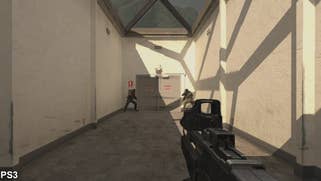
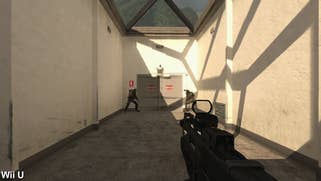

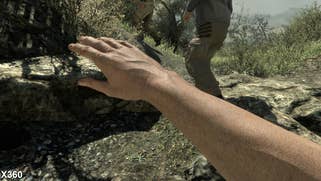



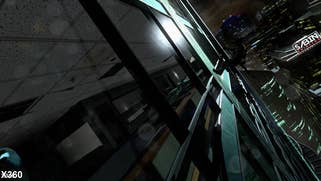
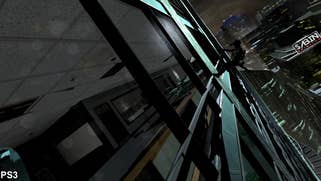
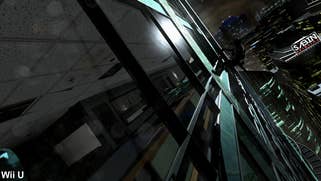
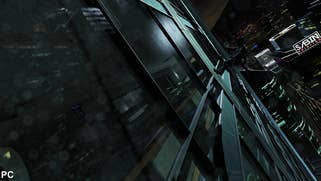


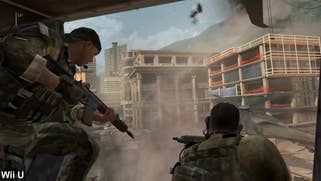

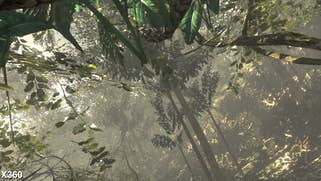

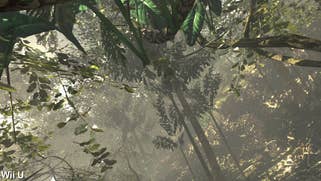

In short, it's impressive stuff, even if the engine doesn't demonstrate the same graphical leap forward as DICE's Battlefield 4 across the board. Clearly Infinity Ward is hell bent on proving that its established rendering technology still has the ability to be expanded and enhanced beyond recognition. That said, beyond the beautiful layer of graphical polish the core gameplay remains firmly rooted in the current generation. The initially impressive sight of crumbling environments collapsing buildings during fire fights is just that - a sight designed to deliver a few fleeting Michael Bay moments with limited interactivity before the action repositions itself across linear corridors and on-rails sections that form a staple part of modern Call of Duty games. In gameplay terms this is still a title fundamentally built around the requirements of seven-year-old technology.
The introduction of DirectX 11 features and the huge increase in graphical complexity compared to previous games also means that achieving a locked 60fps when running at 1080p and with max settings enabled on PC is no longer possible using powerful GPUs like the GTX 770 or Radeon 7970. Our Core i5 3570 and GTX 680 set-up struggled to achieve 60fps in all but the smaller action scenes, with massively variable spikes and dips in frame-rate across a general run of play. Switching from bandwidth hungry 4x MSAA to the lightweight FXAA only made a modest improvement. In order come closer to hitting the desired 60fps update without compromising on graphical quality you'll be looking towards something along the lines of GTX 780 or Radeon R290 graphics cards, or CrossFire and SLI solutions, and even then you may still have issues.
In that respect the engine appears less optimised than DICE's Battlefield 4 and the previously far less demanding Call of Duty games, with Infinity Wards's liberal use of tessellation perhaps being responsible for bringing the hardware to its knees while it pushes a substantial amount of advanced shader effects on screen at the same time - an issue that also plagued Crysis 2 a few years ago after Crytek released a patch taking advantage of DirectX 11 upgrades throughout the game. However, it surely makes for great benchmarking material.
Call of Duty: Ghosts: performance analysis
Moving onto console performance, and the more modest nature of the engine upgrades in these versions causes far fewer problems compared to the PC game. Infinity Ward made great strides in achieving a mostly solid 60fps in Modern Warfare 3 in addition to upping the intensity of the action, and while the same level of parity hasn't been reached here in Call of Duty: Ghosts, we're not looking at a significantly compromised experience in comparison.
Looking closely at our triple-format performance video, the 360 manages to command an advantage in like-for-like scenes over the course of the game where the engine is being pushed to extremes - something that we also see during heavy combat, where the liberal use of smoke and particles causes a bigger performance penalty on the PS3. However, both versions do a decent job of sticking reasonably close to the target 60fps, with many of the smaller fluctuations in frame-rate going by completely unnoticed. It's only when the engine is stressed that we find the sleek perceptual 60fps experience begins to feel more compromised on the PS3 - consistency is somewhat reduced on Sony's system despite the harsh reduction in framebuffer resolution.
"Xbox 360 and PS3 offer up broadly comparable levels of performance, but the Wii U engine hasn't improved much at all compared to last year's disappointing version of Black Ops 2."
The situation is far less favourable where the Wii U is concerned, with an inconsistent level of performance reminiscent of Black Ops 2. Here we find that Call of Duty: Ghosts on Nintendo's console fails to approach the smooth update that forms the basis of the series' fast and responsive controls outside of smaller, less intensive scenes. During the regular hectic shootouts and larger set-piece battle scenes, we see the Wii U game offering up between 30-45fps, with consistency fluctuating between those metrics. While the much lower level of performance doesn't kill the experience by any means, having the brief moments of 60fps gameplay regularly disrupted by variable and extended frame-rate drops completely changes the core feel of the experience, making it feel less like a Call of Duty game.
That said, there are also times when all three versions are reduced to a frame-rate hovering around the 30fps mark for an extended period of time. The end of the Federation Day level sees you sliding down the inside of a collapsing building, shooting away at enemies while avoiding the debris and destruction in your path. However, in the game's biggest set-pieces control is largely taken away from the player, so the reduced level of responsiveness is never an issue, although the drop in fluidity is clearly felt. Towards the end of the sequence, both the 360 and PS3 versions manage to recover the smooth frame-rate the series is known for, but the appearance of further alpha based effects continues to cause the Wii U some trouble.
So, the single-player campaign clearly shows an advantage to the 360, with the PS3 not too far behind in many scenes, and the Wii U failing to approach the same level of performance across the board. But the experience should be a far more closely matched affair during multiplayer matches, where the environments are mostly static and lack the rip-roaring set-pieces that now dominate the campaign. A look at the 360 and PS3 versions shows that this is indeed the case, with both comfortably achieving a solid 60fps for much of the time, bar a few short drops down to around 50fps that mostly go by completely undetected by eye. Similar to the campaign missions, the PS3 succumbs to a few more dips in smoothness, but overall we didn't find this to noticeably intrude on the quality of the gameplay.
"It's a similar story in the multiplayer game - Xbox 360 and PS3 perform well, but the Wii U game is left well behind."
Alternative analyses:
- Call of Duty: Ghosts - Xbox 360 multiplayer performance
- Call of Duty: Ghosts - PS3 multiplayer performance
We had quite high hopes for the Wii U version in this area, too, given just how close Black Ops 2 is in this regard - despite featuring a few more interruptions, performance on Nintendo's console is comparable to that of the 360 and PS3 in Treyarch's title. However, it appears that the developers were unable to optimise the engine to quite the same degree with the new assets, and as such we find that a similarly consistent level of performance isn't demonstrated to the same degree on Nintendo's console. More Detailed maps - such as Tremor and Chasm - see overall performance clearly compromised, while introduction of alpha effects and explosions impact on performance more heavily than they do on the 360 and PS3.
Call of Duty: Ghosts - the Digital Foundry verdict
Last year's Black Ops 2 dared to rewrite some of the Call of Duty rulebook, in the process firmly showing that Treyarch is more than willing to shake up the franchise to keep things from appearing too stale. But besides the increase in graphical spectacle and a few underused ideas we never get a sense that series creator Infinity Ward is looking to expand past its comfort zone in Ghosts. Instead, the gameplay is bolstered by new mechanics that are quickly introduced and then discarded for the rest of the game - such as the introduction of the remote sniper in an early mission, and the inclusion of attack dog Riley, who can be completely forgotten after the game is done using him to advance the wafer-thin plot. Meanwhile, the multiplayer modes are starting to lose some of their lustre, especially when compared to the dynamic environments and vehicular combat of the Battlefield games.
In that sense, the Call of Duty series really needs to evolve in future instalments, taking advantage of the additional power afforded by the next-generation consoles and top-end PC to deliver more than just a bigger bang and prettier pictures, but instead ways to make the blockbuster spectacle feel meaningful again. However, from a technological perspective, Infinity Ward has arguably proven that its underlying engine is ready for next-generation deployment with Call of Duty: Ghosts, even if the sheer number of advanced rendering features fails to match true next-gen titles such as Battlefield 4 and Killzone: Shadow Fall. In that sense it's still a cross-generation game, but one that makes a concerted effort to deliver a meaningful upgrade over the sub-HD current console versions.
In that respect, the PC version represents a huge leap above the console editions and gives us a good idea of what to expect from the upcoming PS4 and XO releases. If you're planning on getting either next-gen console at launch and haven't taken the plunge with Call of Duty: Ghosts on the 360, PS3 or Wii U, we'd certainly suggest holding out a little longer as the graphical upgrade appears worthwhile. Of course the issue of Xbox One's 720p resolution and PlayStation 4's alleged frame-rate problems are still looming with regards to the game - a state of affairs that we are keen to address when we finally get our hands on both consoles in the coming days.
In the here and now, the current-gen Call of Duty experience is best delivered on the 360, followed quite closely by the PS3 version, where stable multiplayer performance is backed up by a campaign that still delivers a good slice of 60fps action, even if frame-rates aren't quite as smooth as on Microsoft's platform. However, the soft-focused look doesn't represent the game in its best light in comparison to the sharper and cleaner 360 release, while the texture bugs are disappointing to see. The real letdown comes with the Wii U version, which sees owners of Nintendo's console once again left with a sub-par experience marred by frequent frame-rate issues and some pretty striking texture quality problems that makes it hard to recommend when both 360 and PS3 offer up smoother gameplay and more enjoyable online play as a result.
